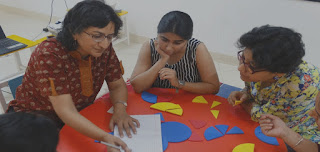Many teachers resist being taught to use technology.
If we say that school is a learning community, then teachers are learners too. For the teachers also the space to differentiate (Teachings in education, 2017) their own learning is required. Teachers, being implementers of curriculum require an autonomy to decide for themselves strategies that they can utilize in the best manner to teach their students.
Granted that there ought
to be some pressure to grow out of comfort zones, however to insist that
everyone uses technology in the same way is to insult the space of autonomy,
for teachers are human beings and not computers running on a software.
As (Prensky, 2008) says,
“The teacher’s role should not be a technological one, but an
intellectual one – to provide the students with context, quality assurance, and
individualized help. (Of course, those teachers who love technology are free to
learn and use it.)” In that the teacher may or may not use technology,
depending on the situation. The teacher’s real role would be to
develop or design a task to stimulate the thinking of the students.
I always believed
in empowering the students with self-study and tried textbook based work when I
was teaching in the national curriculum schools in India. However, it never
worked very well. Textbook as a tool did not attract attention of the students.
“One
reason that the pedagogy of students teaching themselves never caught on as the
mainstream approach – although it has been advocated by many, certainly since
Dewey and probably since Socrates – is that the available tools for learners to
use just were not good enough”.
However, today we
have enough technology tools to use to create a learning environment that is
learner led. The tool I used was open source material readily used online. This
is because of the situation that I was in. I taught IGCSE Maths, where the
school had free Wi-Fi and each student and teacher had a laptop. The school
gave me the space to discover my own personal style of integrating technology
in the lessons. I used this space to develop Maths lessons that were primarily
self-paced within a broad structure.
I had a system that
ran perfectly with the following steps:
1.
Email to students a task sheet with all
instructions, weblinks and reference to text book. A rubric with time lines was
handed too.
2.
Help them to organize themselves into
groups.
3.
Students wold work with their peers to
learn the content and solve problems.
4.
I would be called upon only if they
required.
5.
The students would wind up the work and
move to assessment at their own pace.
6.
A buffer day was given to those who
required.
7.
In the end we gave each other our
reflections to improve the system continuously.
I discovered the
following:
1.
To come to such a program, you require a
good base of relationship with students.
2.
As a teacher I had to be a meticulous
planner and organizer.
3.
As a mentor I had to guide students who
were not very well organized in managing their material.
4.
Overall, the students loved the classes, as
one of them said during a lesson on Percentages, “Now, I am learning the
concept properly!” (% and
self-study using IT, 2019)
While such lessons went
with my nature of going with a flexible flow, when I was asked to use a
smart-board by the head of department, I was quite paralysed. I found the rigid
structure of a smart-board with the content already inputted very off putting
and I avoided it at all cost. I was very hands on with open-source content and playing
around with it to suit the learners’ needs. Being learner centric, I preferred
to be able to tweak the content.
But my colleague was
excellent with a smart board led class and created many successful learner
centric lessons using the same. We were different, but our end goals were same.
I used a blended program with many strategies, while she preferred few
structured programs.
“…technology’s
role – and its only role – should be to support students teaching themselves
(with, of course, their teachers’ guidance.)” (Prensky, 2008)
References:
1.
% and
self-study using IT. (2019, September 12). Retrieved from https://humanemaths.blogspot.com/2019/09/and-self-study-using-it.html.
2.
Prensky, M. (2008). The Role of
Technology in teaching and the classroom. Educational Technology.
Retrieved from http://marcprensky.com/writing/Prensky-The_Role_of_Technology-ET-11-12-08.pdf
3.
Teachings in Education. (2017).
Differentiated instruction: Why, how, and examples. Retrieved from
https://www.youtube.com/watch?v=8BVvImZcnkw (5:30)




Comments